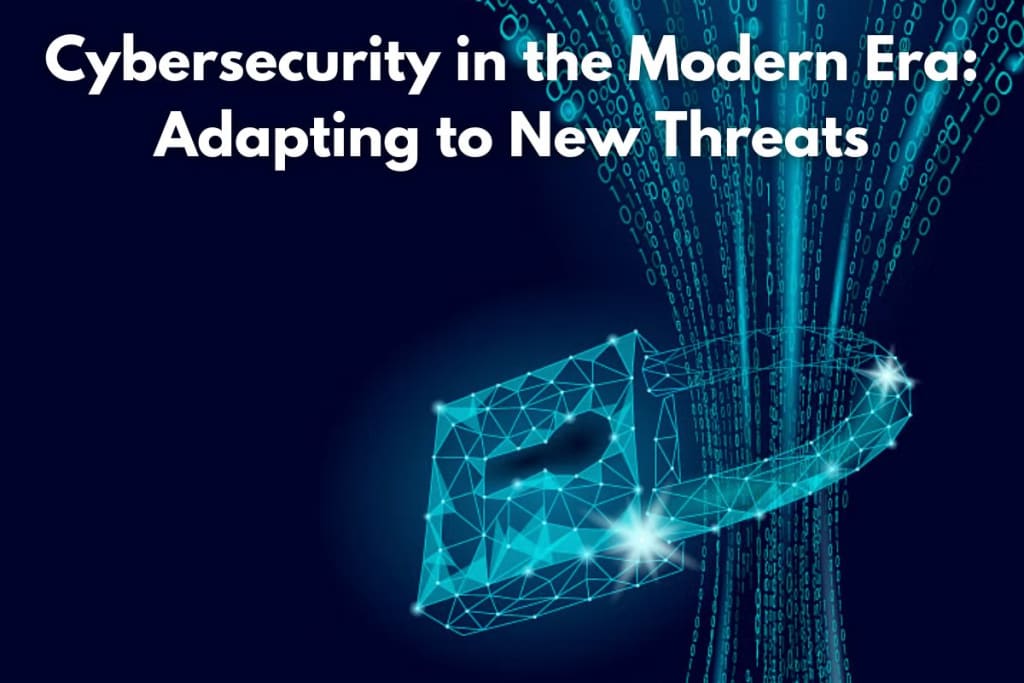Cybersecurity in the Modern Era: Adapting to New Threats
Navigating the Shifting Tides of Cybersecurity in the Digital Age

In an era dominated by digital connectivity, cybersecurity has become a paramount concern. As the era advances, so do the methods of cyber threats. This article delves into the dynamic landscape of present-day cybersecurity, exploring emerging threats, revolutionary defense techniques, and the vital need for agencies to adapt and strengthen their virtual defenses.
Introduction: The Shifting Sands of Cyber Threats
The present generation is characterized by remarkable technological progress, but it also brings evolving cyber threats. From state-of-the-art ransomware attacks to nation-sponsored espionage, the digital landscape is filled with challenges. This phase sets the stage for understanding the urgency of adapting cybersecurity measures to the ever-evolving threat landscape.
1. Rising Threat Actors: Beyond the Conventional-
As cyber threats diversify, so do the individuals responsible for them. Explore the range of threat actors, from individual hackers seeking economic gain to organized cybercrime syndicates and nation-states driven by geopolitical motives. Understanding the motivations and strategies of those actors is crucial for developing effective defense techniques.
2. The Morphing Face of Malware: Advanced Tactics and Techniques-
Malware, the weapon of desire for lots cyber attackers, has evolved beyond traditional viruses. Delve into the world of advanced malware, consisting of polymorphic and fileless variants. Explore how artificial intelligence (AI) and gadget learning (ML) are being harnessed each by means of attackers and defenders on this ongoing cyber hands race.
3. Zero-Day Vulnerabilities: Unseen and Unprotected-
Zero-day vulnerabilities are an essential concern for cybersecurity professionals. This phase explores zero-day exploits, the underground marketplace for such vulnerabilities, and the role of threat intelligence in proactively identifying and mitigating these threats before they can be weaponized.
4. Cybersecurity Beyond Perimeters: Zero Trust Architectures-
Traditional security fashions built round perimeter defenses are proving inadequate within the face of modern-day threats. Enter the concept of Zero Trust, a paradigm shift in cybersecurity that assumes no implicit consider and requires verification from anybody seeking to access resources in a community. Explore the principles and benefits of Zero Trust architectures.
5. Quantum Computing and Cryptography: A Double-Edged Sword-
The advent of quantum computing poses a capacity threat to existing cryptographic strategies. Examine the consequences of quantum computing on cybersecurity and the race to broaden quantum-resistant cryptographic algorithms. As groups prepare for a publish-quantum generation, this phase navigates the demanding situations and opportunities supplied through quantum advancements.
Also Read: The Future of Cloud Computing
6. Threat Hunting and Behavioral Analytics: Proactive Defense Strategies-
The shift from reactive to proactive cybersecurity is exemplified by the use of threat hunting and behavioral analytics. Discover how businesses are adopting proactive approaches to identify and neutralize threats before they materialize. Explore the role of AI-driven analytics in detecting abnormal behavior that may indicate potential security incidents.
7. Securing the Cloud: Challenges and Innovations-
As companies embody cloud computing, securing cloud environments becomes paramount. Unpack the precise challenges related to cloud security, from misconfigured settings to statistics breaches. Discover modern answers, which include Cloud Access Security Brokers (CASBs) and DevSecOps practices, that empower companies to stable their journey to the cloud.
8. The Human Element: Cybersecurity Awareness and Training-
Amidst technological advancements, the human factor stays a important vulnerability. Investigate the function of cybersecurity cognizance packages and education in cultivating a vigilant group of workers. Understand how social engineering assaults goal human psychology and discover techniques for growing a cybersecurity-aware organizational way of life.
9. Internet of Things (IoT) Security: Safeguarding the Connected Ecosystem-
The proliferation of IoT gadgets introduces a brand new frontier for cybersecurity challenges. Explore the safety implications of interconnected gadgets, from clever domestic gadgets to business sensors. Delve into the precise vulnerabilities related to IoT and discover techniques for securing the increasing network of linked gadgets.
10. Cybersecurity Regulations and Compliance: Navigating the Legal Landscape-
The regulatory landscape surrounding cybersecurity is evolving unexpectedly. Examine the impact of worldwide and nearby policies on cybersecurity practices. From GDPR to rising frameworks, apprehend how compliance with cybersecurity guidelines is not best a felony necessity however also a essential aspect of a robust cybersecurity strategy.
Learn More: Cybersecurity Trends
Conclusion: Navigating the Future of Cybersecurity
As the digital landscape continues to evolve, organizations must remain agile in adapting their cybersecurity strategies. Summarize key takeaways, emphasizing the importance of continuous learning, collaboration, and technological innovation in staying one step ahead of emerging cyber threats.





Comments
There are no comments for this story
Be the first to respond and start the conversation.